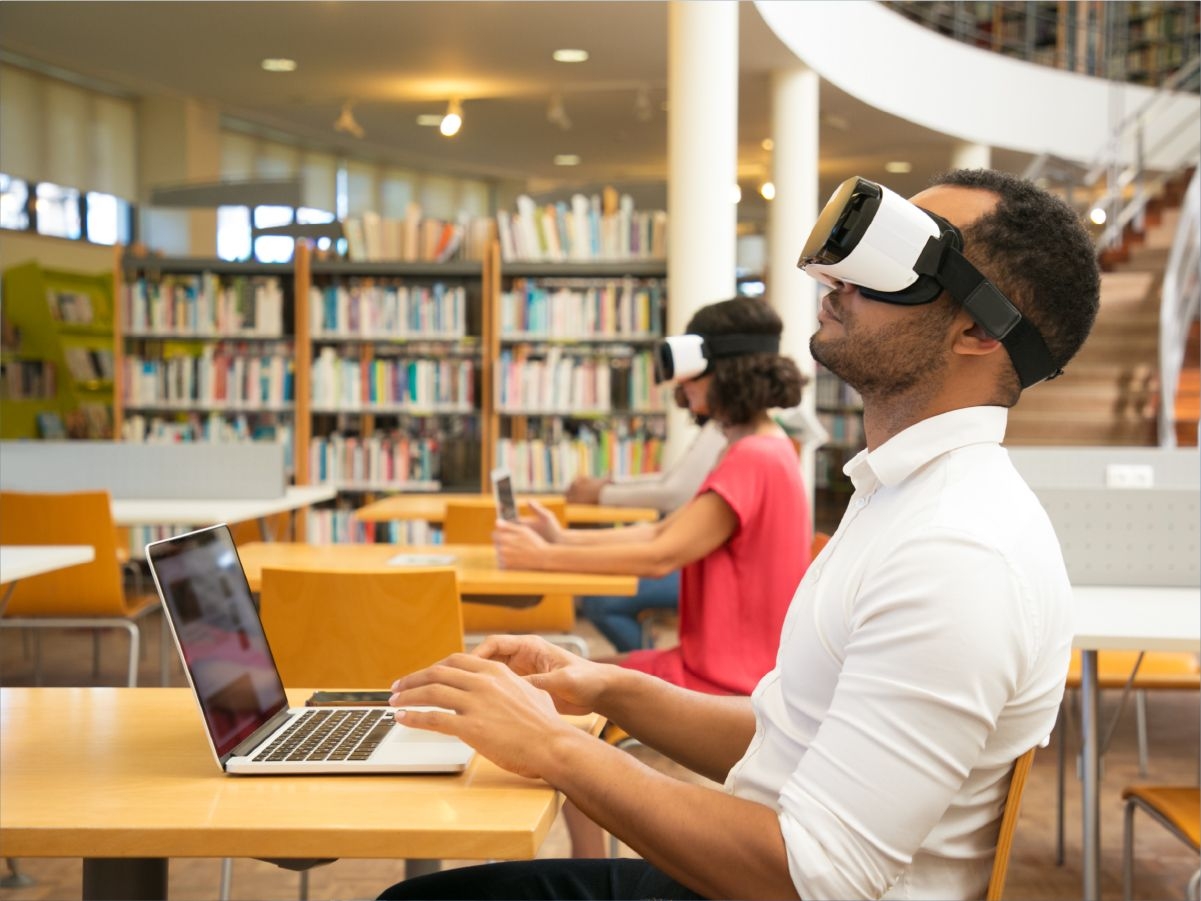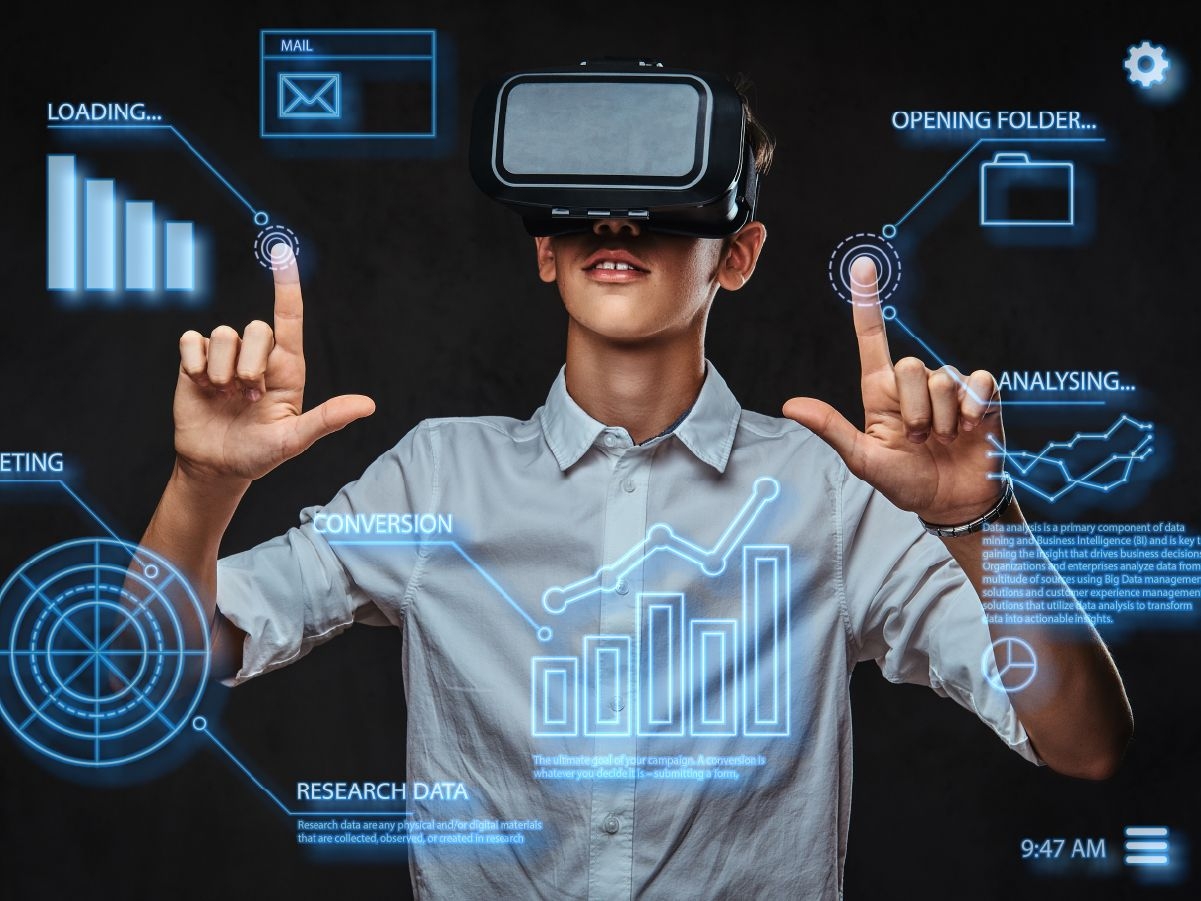Virtual reality, as an immersive technology, is a tried-and-true solution for increasing focus and material learning. It improves memory, awakens curiosity, and even triggers muscle memory by simulating real-life scenarios, making the immersive experience as real as we are willing to believe.
For the same reasons, it is an ideal tool for assisting self-learning. In fact, virtual reality (VR) technology is becoming more popular in education, with an increasing number of schools adopting the technology. But why is VR such an effective learning tool? Is it safe to use around children, who are prone to technology addiction in general?
Let's talk about the difficulties and innovations of virtual reality in education. But before we dig into the details, let’s take a minute to review some basics.
Table of contents:
Virtual reality: the definition
I'm sure you know roughly what virtual reality (VR) is. By equipping yourself with a VR headset, you’re able to immerse yourself (“enter”) in a fully interactive digital experience. The virtual world is in fact a pre-designed, realistically modeled 3D representation of a chosen area – which may or may not exist. This means the simulation can be equally practical as the training scenario, replicating the real-life working environments; as the game area, allowing for a more engaging playthrough; and finally, as the mind-opening immersive experience, providing fully interactive models to learn on.
A controller is needed to move around and interact with the virtual world (as the different interactions are triggered with a pre-programmed set of buttons). Although users are usually aware of the simulated scenario's “fakeness”, the combination of the visual and auditory systems noticeably boosts their engagement. This is significant because humans construct reality using information from their senses, which is why, even when we are aware that we are having a completely digital experience, our bodies respond in the same way.
This gives a strong feeling of presence and immersion. As a result, virtual reality training scenarios will help people pay closer attention and learn more. And this is precisely why more and more industries have started to use it.
Virtual reality in education
Virtual reality is above the differences
Attending scheduled classes with the same group of students promotes functioning as a member of the group and allows them to bond and exist as a mini-society. As in real life, this translates into social interactions, sharing experiences, and – sadly – sorting out a hierarchy of “better” and “worse” students based on their lifestyle, intelligence, wealth, looks, or nationality (depending on the culture in which children are raised).
Everyone wants to be considered “cool”, but no one enjoys being bullied. Everyone wants to finish their classes and assignments on time. In fact, combining those two desires is extremely difficult, resulting in the class being divided into multiple groups with varying levels of advancement – which teachers may or may not prefer. As a result, less time is spent on actual learning and more on figuring out how to postpone the exam, planning how to avoid assignments, and gaining sympathy from the teacher (or even: mercy).
Solution: Virtual reality has the potential to bridge at least some of these gaps, as students have equal access to the immersive learning experience, which can be tailored to an individual's learning pace and translated into as many languages as necessary. This means no more vying for a teacher's attention; no more skipping topics due to the brilliance of the top students; no more cheating on a virtual exam; and no more excluding children from low-income families from virtual field trips (as the whole class can experience the world via VR). At the same time, students are encouraged to interact with one another throughout (and outside) the VR experience.
Virtual reality makes classes more enjoyable
Even the most interesting topic can become boring when our teacher lacks enthusiasm. On the other hand, it's difficult to maintain an inspiring tone when the schedule suggests cramming even more topics into the class in order to finish the program on time. And as the number of topics with little to no practical examples grows, the opposite happens to the students' focus.
As the material resurfaces over time, some teachers decide to use the class as the lecture to dictate notes, which must be supplemented with tons of homework after school. Others will usually bring one or two students to the board to demonstrate the problem-solving method, while the student is usually stressed even more due to the fear of public humiliation. That, or the quick exams at the end of each class, which frequently only serve to teach students how to cheat.
Solution: Virtual reality provides teachers with an experimental field in which to demonstrate a wide range of class-related knowledge in a fun, interactive manner. This is extremely useful in subjects such as:
- Biology and anatomy – by allowing students to explore a "living" body (see breathing lungs, beating heart, multiplying cells), a water cycle, a 100-year-old tree growth, or the dinosaur era.
- Physics, mathematics and astronomy – by teaching about Newton's law of gravity, visualizing complex equations and their impact on our world, and identifying star constellations.
- Geography – by demonstrating regional differences, weather conditions (experience hurricanes, learn how to spot an impending earthquake), and providing students with travel experiences that would otherwise be impossible or impractical
- Chemistry – by allowing for experiments on every type of substantiation without regard for class safety or the cost of safety equipment/ingredient lockers.
- History – by allowing to experience different eras and significant events that have influenced our current times.
This component could be used at higher levels of virtual reality education as well, particularly in the practical training of future engineers, doctors, and other skill-reliant positions. In fact, it is already being used on the other side of the fence, as interns and juniors are already being introduced to the specifics of their jobs through simulated scenarios provided by future employers.
Virtual reality inspires students to go further
This point refers to the experimental learning mentioned in the list above. Because students are free to explore topics on their own, they may become interested in a specific type of topic, which may define their future career. Allowing students to imagine themselves in a realistic setting often helps to pique their interest in a subject. And it's always better to be inspired by something if you've had the opportunity to try it in person as the majority of people tend to be practical and visual learners.
Virtual reality supports online education and distance learning
When students are at home, they tend to be more distracted, focusing on procrastination rather than reviewing the educational content. Although this is natural, it may become a problem when spending extended periods of time at home, such as during flu season, a broken leg, occasional remote education, or, in the most extreme case, another pandemic. Giving a stay-at-home student a VR headset could solve those problems by combining the quality of individual learning with the convenience of adjusting the learning pace to the time of recovery.
The dangers of VR
Although using advanced technology to better humanity appears to be a noble cause, some parents are concerned about putting another gadget in the hands of already tech-addicted children. The Internet is full of 6-year-olds and younger who try to use a book as a touchpad, film their social media intros (or run entire channels), or spend time playing tablet games. In fact, Generation Z is the first generation to not remember a time before the Internet. And is completely addicted to the virtual world.
This is beyond our ability to control. But, at the same time, we can use the proclivity to do something good. VR has the potential to appeal to children because the rules within the world mimic the in-game experience: we can move around, interact (via a controller), and everything is 3D-modeled. And, by distributing learning materials as a “gaming-like” experience, we can actually encourage students to repeat the material several times, ensuring that they remember the VR experience long after it has ended and are eager to reflect on it in future lessons.
It is worth noting that the widespread adoption of VR education is still years away, as the cost of full-class VR headsets is prohibitively expensive for public schools to consider (not mentioning the 3rd world countries). The technology also needs to be adjusted, as the typical virtual reality headset is far too heavy to be worn by an adult for more than 20-30 minutes, and is certainly incompatible with a child's head. There is also the issue of VR sickness, which has symptoms similar to motion sickness and can affect anyone after prolonged exposure to the digital environment – potentially influencing the individual’s pace of learning.
Despite the above-mentioned issues, VR is an excellent educational tool for training adults (i.e. university students) by allowing students learn from mistakes they may make while in the training scenario. It's also a fantastic tool for visualizing complex mechanisms, saving students hundreds of hours spent on YouTube searching for videos that explain how it works.
Conclusion
One of the most compelling arguments for widespread adoption of immersive VR education is the ability to learn more efficiently through immersive experiences, which captures students' attention like nothing else before. This represents a significant swift from traditional methods (reading and writing), as it allows students to learn through digital immersion. As students are 'transferred' into a world without boundaries, their imagination and, consequently, creative thinking grow with each learning session, encouraging them to truly explore new topics. This provides the necessary learning experience to stimulate progress in the chosen field.
The virtual revolution – similarily to the further advancements of mixed reality and augmented reality as well) has yet to be witnessed due to the pandemic slowdown and virtual reality headsets price increases. But when it arrives, it will undoubtedly adapt to multiple sectors at once. While sitting in a silent class of students wearing VR headsets may seem a little too futuristic at this point, the ability to tailor the entire learning program to an individual's learning capacity means better educated, more dedicated specialists.
And if you don't want to wait for those specialists to arrive in the future, let us advise you on how to improve your team's skills with dedicated training scenarios designed to address the most pressing issues in your current business strategy.



